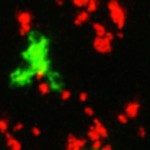Link to Pubmed [PMID] – 20956985
Immunol. Cell Biol. 2011 May;89(4):549-57
The movement of proteins within cells can provide dynamic indications of cell signaling and cell polarity, but methods are needed to track and quantify subcellular protein movement within tissue environments. Here we present a semiautomated approach to quantify subcellular protein location for hundreds of migrating cells within intact living tissue using retrovirally expressed fluorescent fusion proteins and time-lapse two-photon microscopy of intact thymic lobes. We have validated the method using GFP-PKCζ, a marker for cell polarity, and LAT-GFP, a marker for T-cell receptor signaling, and have related the asymmetric distribution of these proteins to the direction and speed of cell migration. These approaches could be readily adapted to other fluorescent fusion proteins, tissues and biological questions.

